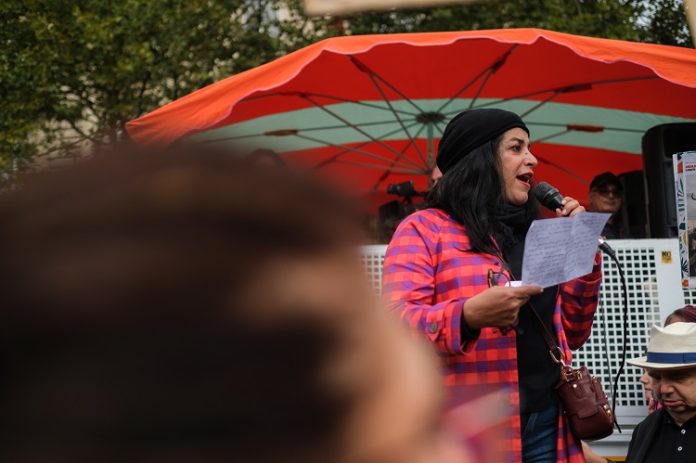
By Ahmad Rafat
Seventeen Iranian and non-Iranian illustrators including Marjane Satrapi have released a book titled “Woman, Life, Freedom.” The book, originally published in French, has been translated into English and other languages, with Satrapi coordinating the project. The Persian version of the book is freely accessible online.
[aesop_image img=”https://kayhanlife.com/wp-content/uploads/2023/11/azadi-zendegi-zan.jpg” panorama=”off” credit=”Headscarves burning. KL” align=”center” lightbox=”on” captionsrc=”custom” captionposition=”left” revealfx=”off” overlay_revealfx=”off”]
The illustrators include Mana and Touka Neyestani.
Satrapi gained worldwide recognition with the release of her graphic novel “Persepolis” ” and its film adaptation, which she co-directed and won the Special Jury Prize for at the 2007 Cannes Film Festival. She was also in the competition at the Venice Film Festival with the film “Chicken with Plums,” starring Golshifteh Farahani.
Satrapi came up with the concept for the book together with experts and researchers such as Abbas Milani, a historian and the director of Iranian Studies at Stanford University in California; and Farid Vahid, a Paris-based academic specialized in Iranian studies. Satrapi then collaborated with other writers and illustrators on the publication.
“They agreed to illustrate and design for us based on texts and storyboards drawn up by experts,” she wrote in the book’s introduction. “We chose four Iranian illustrators and 13 illustrators from Europe and the United States.I wrote several texts, drew several new designs, and produced the cover, despite the fact that I had said goodbye to illustration work in 2003.”
The challenge of publishing an illustrated book catering to Iranian and foreign audiences simultaneously was not an easy one. Iranian audiences, who are fully aware of the events that took place last year in Iran, have a different perspective than foreigners who may be unfamiliar with the history and past of Iran, and who did not follow the news of the past year on a daily basis.
Neyestani, one of the book’s illustrators, said: “When I am engaged in drawing an image, I never differentiate between my Iranian and non-Iranian audience: I prioritize communication with the non-Iranian audience, and acknowledge the need for more explanation of the details, background, and people involved in the story. The readership of this book consists of people who have heard about the events of 2022 in Iran from afar, who are thirsty for more information, and who can easily get some of this information from an image in the book. Documenting events will also be valuable in 10 to 15 years to the new generation of Iranians.”
In the introduction to the book, Satrapi wrote that “Woman, Life, Freedom” aims to depict the complicated events in Iran and convey them to a non-Iranian audience. The narrative focuses on what is a continuous and dynamic movement.
United Nations Must Investigate Armita’s Death in Tehran Metro, Says Human Rights Watch
The second aim of the book, she wrote, is to reassure Iranians that they are not alone. Although world politicians only follow their own path and take no steps to benefit the Iranian people, civil society in the West is supportive of their cause. Western artists have collaborated in the creation of the book, which is proof of their solidarity.
The first chapter, titled “Important Events,” describes the protests that followed the killing of Mahsa Amini while in the custody of the Morality Police in Tehran in September 2022 and the protestors’ slogan of ‘Woman, Life, Freedom’ which was reflected in the song Baraye by Shervin Haji-Pour. The chapter also refers to the government’s response: the widespread arrests, executions of protesters, and chain poisoning of school students.
The second chapter covers the history, culture, and politics of Iran, including past revolutions, traditional ceremonies such as Nowruz (the Persian New Year), contemporary governance, and censorship.
Chapter Three discusses the ethical and behavioral characteristics of the ruling system and its relationship with the people.
The fourth chapter is a visual roundtable discussion titled “What’s Next,” featuring Satrapi, Farid Vahidi, the journalist Jean-Pierre Perrin, and Abbas Milani.
The book has had an enormous impact in France since its publication.
In a lengthy article, the French daily Le Monde said Satrapi and her co-authors aimed to change prevailing perceptions of Iran in the West and put an end to the world’s indifference to the Islamic Republic’s actions.
Satrapi herself highlighted the regime’s killings of 20,000 to 30,000 political prisoners between 1981 and 1988 as a result of the world’s indifference, and said there was the possibility of it causing more harm if the international community remained indifferent.
Despite her concerns about the situation in Iran in the short term, Satrapi said she was very hopeful about the future. She said the regime was empty and lifeless, and there was nothing left of it.
Artist Minoo Emami To Burn Her Own Paintings In Solidarity With Iranian Women’s Struggle





















